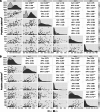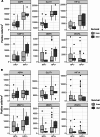Aspartate-β-hydroxylase and hypoxia marker expression in head and neck carcinomas: implications for HPV-associated tumors
- PMID: 38858774
- PMCID: PMC11163809
- DOI: 10.1186/s13027-024-00588-1
Aspartate-β-hydroxylase and hypoxia marker expression in head and neck carcinomas: implications for HPV-associated tumors
Abstract
Background: A proportion of head and neck carcinomas (HNSCCs) are induced by high-risk human papillomaviruses (HPVs) and are associated with better patient outcomes compared to patients with HNSCCs related to tobacco and alcohol abuse. In the microenvironment of solid tumors, including HNSCCs, oxygen levels are often reduced, and a hypoxic state is induced. This can lead to a poor treatment response and a worse patient prognosis. One of the hypoxia-responsive genes is aspartate-β-hydroxylase (ASPH), whose activity promotes the growth, invasiveness, and metastasis of many types of solid tumors.
Methods: In our study, HNSCC samples were analyzed for the expression of ASPH and selected endogenous hypoxia markers by real-time PCR and/or multiplex fluorescence immunohistochemistry.
Results: Except for the EPAS1 gene, which had higher mRNA expression in the HPV-negative group of HNSCC (p < 0.05), we found no other differences in the expression of the tested genes that were related to HPV status. On the contrary, a statistically significantly higher number of cells producing ASPH (p < 0.0001), HIF1A (p < 0.0001), GLUT1 (p < 0.0001), and MMP13 (p < 0.05) proteins were detected in the HPV-positive tumor group than in the HPV-negative sample group. All the evaluated markers, except for MMP9/13, were more abundant in the tumor parenchyma than in the tumor stroma. The Cox proportional hazard models showed that increased numbers of cells with GLUT1 and HIF1A protein expression were positive prognostic markers for overall and disease-specific survival in patients independent of HPV tumor status.
Conclusion: The study examined HNSCC samples and found that elevated ASPH and hypoxia marker proteins, typically associated with poor prognosis, may actually indicate active HPV infection, the strongest prognostic factor in HNSCC patients. In cases where HPV status is uncertain, increased expression of HIF1A and GLUT1 can serve as positive prognostic factors.
Keywords: Aspartate-β-hydroxylase; Head and neck cancer; Human papillomavirus; Hypoxia; Prognosis.
© 2024. The Author(s).
Conflict of interest statement
The authors declare no competing interests.
Figures




Similar articles
-
High stromal carbonic anhydrase IX expression is associated with decreased survival in P16-negative head-and-neck tumors.Int J Radiat Oncol Biol Phys. 2011 May 1;80(1):249-57. doi: 10.1016/j.ijrobp.2010.11.059. Int J Radiat Oncol Biol Phys. 2011. PMID: 21300470
-
Bioinformatic analysis identifies HPV-related tumor microenvironment remodeling prognostic biomarkers in head and neck squamous cell carcinoma.Front Cell Infect Microbiol. 2022 Nov 8;12:1007950. doi: 10.3389/fcimb.2022.1007950. eCollection 2022. Front Cell Infect Microbiol. 2022. PMID: 36425786 Free PMC article.
-
PD1+CD8+ Cells Are an Independent Prognostic Marker in Patients with Head and Neck Cancer.Biomedicines. 2022 Nov 3;10(11):2794. doi: 10.3390/biomedicines10112794. Biomedicines. 2022. PMID: 36359314 Free PMC article.
-
Hypoxia and Its Influence on Radiotherapy Response of HPV-Positive and HPV-Negative Head and Neck Cancer.Cancers (Basel). 2021 Nov 26;13(23):5959. doi: 10.3390/cancers13235959. Cancers (Basel). 2021. PMID: 34885069 Free PMC article. Review.
-
A Review of HPV-Related Head and Neck Cancer.J Clin Med. 2018 Aug 27;7(9):241. doi: 10.3390/jcm7090241. J Clin Med. 2018. PMID: 30150513 Free PMC article. Review.
References
-
- Bisheshar SK, van der Kamp MF, de Ruiter EJ, Ruiter LN, van der Vegt B, Breimer GE, et al. The prognostic role of tumor associated macrophages in squamous cell carcinoma of the head and neck: a systematic review and meta-analysis. Oral Oncol. 2022;135:106227. - PubMed
Grants and funding
LinkOut - more resources
Full Text Sources
Miscellaneous

